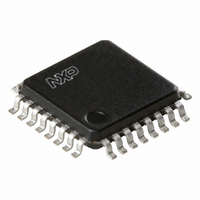TDA8002CG/C1,518 NXP Semiconductors, TDA8002CG/C1,518 Datasheet - Page 8

TDA8002CG/C1,518
Manufacturer Part Number
TDA8002CG/C1,518
Description
IC INTERFACE CARD 32-LQFP
Manufacturer
NXP Semiconductors
Datasheet
1.TDA8002CGC1518.pdf
(28 pages)
Specifications of TDA8002CG/C1,518
Package / Case
32-LQFP
Controller Type
Smart Card Interface
Interface
Analog
Voltage - Supply
3 V ~ 6.5 V
Current - Supply
140mA
Operating Temperature
-25°C ~ 85°C
Mounting Type
Surface Mount
Maximum Operating Temperature
+ 85 C
Minimum Operating Temperature
- 25 C
Mounting Style
SMD/SMT
Lead Free Status / RoHS Status
Lead free / RoHS Compliant
Lead Free Status / RoHS Status
Lead free / RoHS Compliant, Lead free / RoHS Compliant
Other names
568-3518-2
935261709518
TDA8002CGB-T
935261709518
TDA8002CGB-T
Available stocks
Company
Part Number
Manufacturer
Quantity
Price
Company:
Part Number:
TDA8002CG/C1,518
Manufacturer:
NXP Semiconductors
Quantity:
10 000
Philips Semiconductors
FUNCTIONAL DESCRIPTION
Power supply
The supply pins for the chip are V
DGND1 and DGND2. V
in the range of 3.0 to 6.5 V. All card contacts remain
inactive during power-up or power-down.
On power-up, the logic is reset by an internal signal.
The sequencer is not activated until V
V
automatic deactivation sequence of the contacts is
performed.
Chip selection
The chip select pin (CS) allows the use of several
TDA8002Cs in parallel.
When CS is HIGH, the pins RSTN, CMDVCC, MODE,
CV/TV, CLKDIV1, CLKDIV2, CLKSEL and STROBE
control the chip, pins I/OUC, AUX1UC and AUX2UC are
the copy of I/O, AUX1 and AUX2 when enabled (with
integrated 20 k pull-up resistors connected to V
OFF is enabled.
When CS goes LOW, the levels on pins RSTIN,
CMDVCC, MODE, CV/TV, CLKDIV1, CLKDIV2 and
STROBE are internally latched, I/OUC, AUX1UC and
AUX2UC go to high-impedance with respect to I/O, AUX1
and AUX2 (with integrated 100 k pull-up resistors
connected to V
Supply voltage supervisor (V
This block surveys the V
pulse of 10 ms minimum (t
output during power-up or power-down of V
This signal is also used for eliminating the spikes on card
contacts during power-up or power-down.
When V
started. The ALARM output is active until this delay has
expired. When V
and a deactivation sequence of the contacts is performed.
1999 Oct 12
th2
IC card interface
+ V
hys2
DD
reaches V
(see Fig.6). When V
DD
DD
) and OFF is high-impedance.
falls below V
th2
DDA
DD
+ V
W
supply. A defined retriggerable
and V
hys2
) is delivered on the ALARM
DD
, an internal delay (t
DD
th2
DDD
)
DDA
, ALARM is activated
falls below V
, V
(i.e. V
DD
DDD
reaches
DD
DD
, AGND,
(see Fig.6).
) should be
th2
DD
, an
W
) and
) is
8
Clock circuitry
The TDA8002C supports both synchronous and
asynchronous cards. There are three methods to clock the
circuitry:
When CLKSEL is HIGH, the clock should be applied to the
STROBE pin. When CLKSEL is LOW, the internal
oscillators is used.
When an internal clock is used, the clock output is
available on pin CLKOUT. The RC oscillator is selected by
making CLKDIV1 HIGH and CLKDIV2 LOW. The clock
output to the card is available on pin CLK. The frequency
of the card clock can be the input frequency divided by
2 or 4, STOP low or 1.25 MHz, depending on the states of
CLKDIV1 or CLKDIV2 (see Table 1).
When STROBE is used for entering the clock to a
synchronous card, STROBE should remain stable during
activation sequence otherwise the first pulse may be
omitted.
Do not change CLKSEL during activation. When in
low-power (sleep) mode, the internal oscillator frequency
which is available on pin CLKOUT is lowered to
approximately 16 kHz for power economy purposes.
Apply a clock signal to pin STROBE
Use of an internal RC oscillator
Use of a quartz oscillator which should be connected
between pins XTAL1 and XTAL2 or an external clock
applied on XTAL1.
Product specification
TDA8002C















